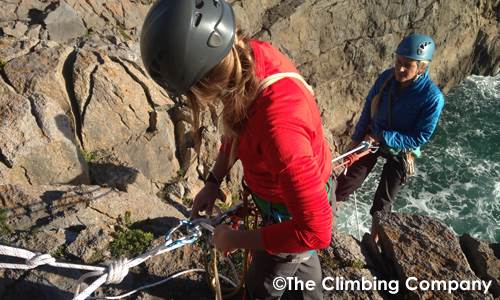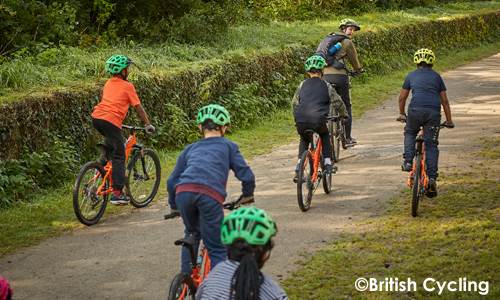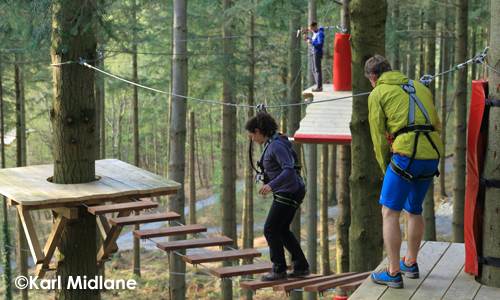We all love the adventure activities that brought us into this business and most of us spend our spare time going paddling, sailing, climbing, biking, hill walking, skiing, kite surfing or enjoying numerous other adventure sports. This degree of passion is one of the reasons why adventure education is such a vibrant field and instructors need to be aware that it comes at a price, if not managed correctly.
Imagine being unable to walk downhill because your knees are worn out, unable to paddle because of chronic ear problems, unable to sail because of permanent back injury. Some can no longer even contemplate such activities as a result of a serious accident. At least some of these instructors who have ended up with these problems could have avoided them with better working (and playing) practices.
Accident rates among adventure activity workers are recognised as being low when compared to other industries, but the evidence is that those that do occur tend to be serious ones and over the years have even resulted in cases involving permanent disability and death.
1 - Personal safety

To survive working in the outdoors you need to have a good attitude towards your personal safety. Many instructors are originally attracted to the freedom, excitement and unconventionality of adventure sports; this doesn’t mean you can ignore the rules and systems designed for your own safety.
You are not invincible. Most accidents occur in simple circumstances.
Avoid complacency, overconfidence and over ambition. All of them increase the risks to you and those around you. A good practitioner will carry out a dynamic risk assessment every time they visit a crag or paddle a river, regardless of how many times they’ve been there before. If you make incorrect assumptions based on overfamiliarity, you might not spot that loose block or fallen tree until it’s too late. Peer pressure, whether it’s real or perceived, can lead to a similar outcome.
Repetitive tasks and distractions can also increase the risks to your personal safety. Flexible working patterns and a professional approach can help to reduce the risks. A good attitude to safety is vital.
Lone working. Working in the outdoors may involve being alone and away from immediate help. Assessing DofE or putting out orienteering controls are just two examples of this. Make sure that you have thought about this beforehand and follow your employer’s guidance.
Working whilst pregnant. Employers should have a policy based on a risk benefit assessment covering expectant mothers at work and you should have regular conversations with your employer during your pregnancy.
Personal safety - top tips
- Make your own safety a priority, even when assisting a participant in difficulty. Your priorities in order are: self, team, victim, equipment (STVE).
- Get enough sleep.
- Eat and drink enough to fuel your body and brain.
- Focus when carrying out safety-related tasks; ask yourself, “what if?”
- Use personal protective equipment appropriate to the activity.
- Have a discussion with your employer if you are pregnant.
- Download and read ‘Personal Safety at Work’ https://www.suzylamplugh.org/personal-safety-leaflets
2 - Judgement and decision making

As someone who works in adventurous activities outdoors you will recognise that the environments in which you operate - cliffs, rocky mountains, white water rivers, the sea, etc. - are hazardous.
Through the application of skill and good judgment, your role is to reduce the risks to a tolerable level for you and your participants.
Instructors are often very aware of the primary hazards that they have identified in a situation but you also need to be aware of secondary hazards.
- Are you safe on a ledge? Do you always concentrate and stay tied in?
- Are you safe in an eddy? Do you always concentrate and keep control of your boat?
- On winter ascents have you fully considered the avalanche danger as well as the technical difficulties of the route?
Good judgement and decision making skills are developed over time as you learn from your own experiences and those of others. A good instructor is always learning from this process of reflection and analysis so don’t be afraid to share your near miss experiences with others.
It is also important to think about your work in the context of safeguarding. Instructing outdoor activities sometimes necessitates helping participants with equipment that brings you into close contact. Administering first aid and fitting harnesses are just two examples of these. Your employer will have a safeguarding policy and this will normally outline expected protocols and behaviour of staff in this context.
Formal systems relating to personal disclosures by a young person (for example, of abuse) are aimed to protect both the young person and the worker.
Judgement and decision making - top tips
- Learn from your experiences – why did/didn’t things go to plan?
- Be flexible when planning to give yourself options; don’t feel compelled to do something if it’s not appropriate.
- Learn from the experiences of others, especially when things go wrong.
- Have a cautious, thoughtful and well informed approach to risk management.
- Read and follow carefully your employer’s safeguarding policy.
3 - Injury avoidance

There are two distinct types of injuries to adventure activity workers: chronic and catastrophic. Chronic injuries develop over time and are often long lasting. Catastrophic injuries occur suddenly and can have serious, long term effects. Both can have a major impact on your ability to work.
Chronic injuries
Common chronic injuries include surfer’s ear, shoulder instability, cartilage and tendon issues in the knee joint, tendonitis in the wrist/elbow and back pain. Endless repetitions of poor movement patterns are often the root of the problem and can lead to significant soft tissue injuries in later life. It can be difficult to spot the cumulative effects and you may not recognise them until years later, when it may be too late.
Unfortunately, we are often our own worst enemies. After a day working on the lake with a group, many canoe coaches will be back in their boats that evening for a personally challenging run down one of the local rivers. Climbers, bikers and sailors all have similar recreational patterns which help with personal motivation and feelings of accomplishment.
The drawbacks of such an active lifestyle are that levels of fatigue can increase, potentially jeopardising your judgement and decision making ability, and minor injuries are unlikely to recover if the root cause is not addressed. Appropriate rehabilitation is really important for recovery and long term employment in the outdoors. Where soft tissue is concerned, scar tissue means that often, repair is never as good as the original and weaknesses accumulate.
Freelancers are at particular risk, as it is often hard to turn work down, and there is no long term employer monitoring your work pattern.
Most employers take their legal requirement to protect employees very seriously. They are your first source of information on specific local hazards such as radon gas accumulations in caves or water borne infection. Imaginative contracts offering varying work patterns may well be one of the best solutions to repetitive injury - why not take this up with your employer?
Avoiding chronic injuries - top tips
Equipment and clothing
- Make sure you have access to appropriate equipment and clothing that can reduce the chances of chronic injuries developing, for example warm headwear or ear plugs can help avoid surfer’s ear and walking poles can help reduce the impact on knees.
Working systems
Follow your employer’s guidance regarding safe operating procedures for example:
- Encourage clients to lift boats properly and as a group. Some commercial rafting guides are required not to involve themselves in moving rafts on land.
- Spread emergency equipment amongst the group so that you are not carrying all of it.
- Ensure boats have air bags fitted to reduce the volume of water to be emptied.
Body awareness
- Learn to listen to your body so that you notice any changes and can take action if something doesn’t feel right.
- Good posture is about more than just standing or sitting in alignment, it’s about engaging the right muscles for each movement. Lazy glutes and overdeveloped back or chest muscles are the cause of many chronic injuries – do you know how to activate and engage them properly?
Catastrophic injuries
Within adventure activities catastrophic accidents appear to be most likely when operating at height, on water, or travelling at speed. As a practitioner and instructor, you will likely manage hazards well nearly all of the time. It only takes one mistake or error in judgement to increase the chances of something going seriously wrong because those hazards always exist.
In the last thirty years drownings have been the cause of several fatalities affecting both workers and participants. As a result, some excellent guidance aimed, in particular, at the difficult water/rock margin has been produced.
Avoiding catastrophic injuries - top tips
- Remember that the hazards you’re used to managing always exist.
- Your personal safety should always be your top priority.
4 - Health and well-being

The benefits of the outdoors for health and well-being are becoming more and more widely understood.
Most instructors are very good at radiating positivity and enthusiasm to their clients, but behind this façade they can have the same issues and feelings of anxiety or depression as workers in any other field. Cumulative fatigue, or a sense of failing as the years advance, can all take their toll and once a condition is established it can start to affect your professional judgment and your personal life.
You will be exposed to a large number of individuals during your career, some of whom may have their own mental health issues. You may also be involved in or witness a serious accident or near miss either at work or during your spare time. It’s important to recognise when you might need some support to deal with any issues that are affecting you.
Health and well-being – top tips
- Look out for each other and don’t be too shy to talk about how you feel.
- Don’t hesitate to seek help from a senior colleague or your doctor. If your organisation offers support in the immediate aftermath of a traumatic event to help avoid long term stress known as PTSD, then make sure you take it.
- If you are struggling with your mental health, your ability to work effectively may be compromised, as it would be for someone with a broken ankle or other physical injury. Rehabilitating your mind is just as important.
- As with safeguarding, make sure you know how to pass on concerns you might have about a participant’s or colleague's mental health. (There are many good mental health first aid courses available.)
5 - Aggressive or challenging participants

In some areas of adventure education, workers may regularly be faced with behaviour from clients that is aggressive and challenging. At best this is disconcerting, at worst a terrifying experience as behaviour swings from aggressive posturing to the ‘worst case’ situation of being physically attacked. The most likely time for this to occur is outside formal activity time, particularly in residential situations. Remember also that aggressive behaviour is not confined to certain individuals, but can be manifested by almost anyone under the wrong circumstances.
Fights do occur and staff will usually feel obliged to intervene, possibly at some threat to their own well-being. Do not underestimate the potential danger of doing this. You need to operate cautiously and conservatively. The most important consideration is your own safety – just like rescuing someone from any other dangerous situation. Wherever possible, aim to defuse the situation and try to get training to prepare you for this. Don’t be a dead hero! Seriously aggressive encounters are beyond the skills of most outdoor instructors.
Organisations working with challenging individuals will normally have:
- Policies and procedures regarding child protection, discipline, reporting of incidents and violent behaviour.
- Methods and means of gaining important information about the young people they are working with, in order to ensure that appropriate staff are given responsibility and are aware of the young people’s needs.
- Access to specialist departments, staff or agencies that can advise and give support.
- Staff training that is proportionate, relevant and timely. Recognition of behaviour patterns, avoidance techniques and training in how to ‘defuse’ may be essential topics.
- Opportunities to review the above with staff from time to time.
- Risk assessments identifying the main hazards.
The support of visiting staff from the school or agency can be invaluable since they will often have relationships with individuals which have been built up over a longer period of time.
It is reasonable for staff to expect some emotional support to be available in challenging work of this kind and be able to discuss situations with an experienced colleague. In some situations personal and professional counselling may be necessary.
Aggressive and challenging participants – top tips
- Prioritise people’s safety as you would in a first aid scenario: you, the group, the individual.
- Familiarise yourself with standard operating procedures wherever you are working to find out what’s expected of staff – there are various ways to do this that don’t involve reading pages and pages of text. Encourage your colleagues to be creative about this.
- Speak to senior staff if you need help.
- Read ‘Personal Safety at Work’ https://www.suzylamplugh.org/personal-safety-leaflets
6 - Other health issues

People working in the outdoors should be aware of hypothermia, hyperthermia, frost bite, sunburn, dehydration and similar conditions. Less common but equally serious are the illnesses associated with ticks (Lyme disease) and rodents (Weil’s Disease). Awareness of these illnesses is of course equally important for participants.
Other health issues – top tips
- Consider your participants’ well-being as well as your own.
- Familiarise yourself with standard operating procedures wherever you are working to find out your employers guidance on these issues.
- Be aware of the importance of skin protection from sun damage. Use a sun cream with a minimum SPF of 30+ and UVA 4* in conjunction with appropriate clothing, headgear and shade: https://www.nhs.uk/live-well/healthy-body/sunscreen-and-sun-safety/
- Online guidance regarding Lyme, Weil’s and similar diseases is updated regularly; make sure you are reading the latest version of the information:
- www.gov.uk/government/publications/tick-bite-risks-and-prevention-of-lyme-disease https://www.rospa.com/leisure-safety/water/advice/weils-disease/